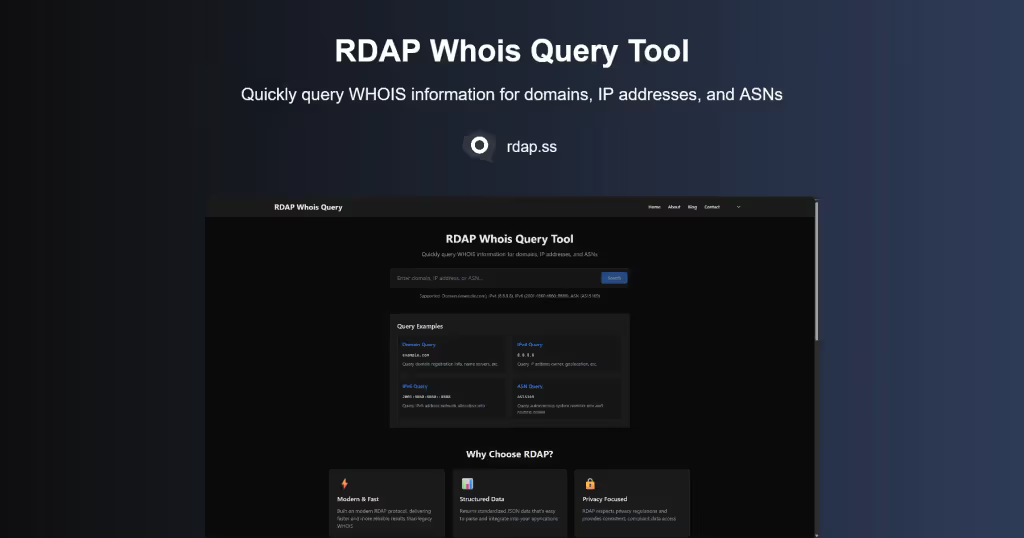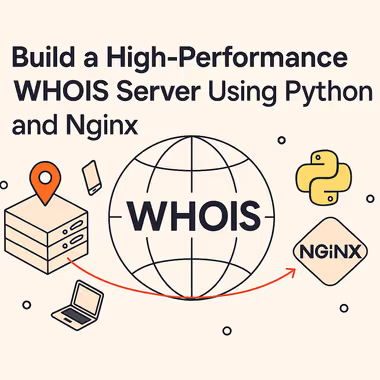RDAP.SS - A Modern Whois Lookup Site Powered by the RDAP Protocol
RDAP.SS is a Whois lookup website built on top of the RDAP protocol. In this post, we’ll briefly explain what RDAP is, why it matters, and how you can use it.

1.What Is the RDAP Protocol?
RDAP stands for Registration Data Access Protocol.
It was developed by the IETF (Internet Engineering Task Force) as a modern, secure, and machine-readable replacement for the traditional Whois system.
RDAP provides standardized access to registration data for:
- Domains
- IP addresses (IPv4 / IPv6)
- ASNs (Autonomous System Numbers)
The protocol is defined in the RFC series 7480 – 7484.
2.RDAP vs. Whois - What’s the Difference?
Here’s a quick comparison between the two:
| Feature | WHOIS | RDAP |
|---|---|---|
| Transport | Plain TCP text | HTTPS RESTful API |
| Data format | Unstructured text | Structured JSON |
| Internationalization | Poor (encoding varies) | Full UTF-8 support |
| Security | No encryption or auth | HTTPS + OAuth support |
| Distributed lookup | Manual redirection | Built-in bootstrap mechanism |
| Standardization | Inconsistent formats | Uniform, machine-readable schema |
In the old Whois world, clients connected to port 43, sent a plain-text query, and received… well, whatever the server felt like sending back.
Every registry had its own format, sometimes the field for the registrant’s email was Registrant Email, sometimes Contact Email, or something even more exotic.
As a result, developers had to write endless regex parsers just to extract data that should’ve been structured in the first place.
(If you’ve ever tried to parse Whois data, you probably still wake up sweating from that nightmare.)
Here are some of the biggest problems with the old Whois protocol:
1.No structure, no standard API.
Every registry returns data differently, so automation is painful.
2.No encryption.
Port 43 uses plain text, meaning your ISP can literally see which domains you’re querying. Not great in 2025.
3.No access control.
Whois servers can only see your IP. They can’t differentiate users, apply permissions, or enforce identity-based limits.
4.Messy management.
Each TLD requires a custom Whois server definition, since there’s no global “bootstrap” list like RDAP provides.
3.Why RDAP Is Awesome
RDAP fixes all of the above, and adds a bunch of nice modern features on top.
1.Standardized JSON Output
RDAP responses are structured JSON objects with clearly defined fields.
For example:
{
"objectClassName": "domain",
"ldhName": "example.com",
"status": ["active"],
"entities": [...]
}No more regex nightmares, your code can finally just parse and go.
2.A Unified API
RDAP runs over HTTP/HTTPS using a RESTful API.
You can make simple GET requests, filter results, paginate, or even script it in your favorite language.
Example:
GET https://rdap.verisign.com/com/v1/domain/example.com
This will return structured data directly from the registry, no scraping, no guesswork.
3.Automatic Bootstrap
RDAP clients don’t need to know which registry to ask.
They automatically follow IANA’s bootstrap data to find the correct RDAP server for each TLD or RIR.
According to RDAP.org, about 77% of registries have already developed RDAP, which means most lookups now “just work.”
Only a few legacy TLDs still require manual configuration.
4.Security and Privacy
All RDAP communication happens over HTTPS, ensuring data integrity and confidentiality, no more plaintext leaks.
Registries can also implement OAuth 2.0 or token-based authentication, returning different data based on the requester’s role (e.g., public user, registrar, or law enforcement).
This design is fully aligned with GDPR and other modern privacy standards.
5. Extensibility
RDAP supports extensions, allowing registries to add custom fields without breaking compatibility.
Example:
"rdapConformance": ["rdap_level_0", "icann_rdap_technical_implementation_guide_0"]
That means future improvements don’t require reinventing the wheel (or the protocol).
4. Introducing RDAP.SS
Inspired by RDAP’s advantages, I built a small, modern Whois lookup site: RDAP.SS
It’s powered by Next.js, Tailwind CSS, and Redis caching, all the usual suspects for a fast, modern web app.
Currently, it supports queries in the following formats:
- Domain →
https://rdap.ss/whois/google.com - IPv4 →
https://rdap.ss/whois/8.8.8.8 - IPv4 CIDR →
https://rdap.ss/whois/8.8.8.0/24 - IPv6 →
https://rdap.ss/whois/2001:4860:4860::8888 - IPv6 CIDR →
https://rdap.ss/whois/2001:4860::/32 - ASN →
https://rdap.ss/whois/AS15169
Note: Only TLDs whose registries support RDAP protocol can be queried. If a registry doesn’t have an RDAP endpoint yet, the lookup will return an error (sorry, dot legacy fans).
If you run into any bugs or have feature ideas, feel free to open an issue on GitHub


